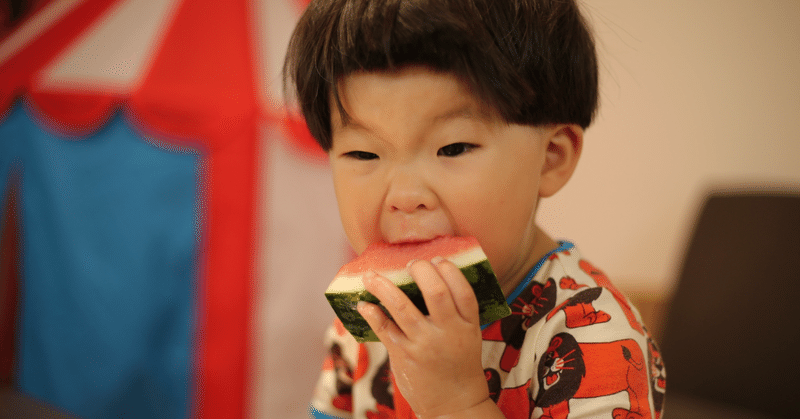
【英語記事から学ぶ】「直感に従って食べる」のすすめ
今回は、アメリカの育児雑誌『Parents』2022年4月号の記事を紹介します。
記事のタイトルは"How to Raise an Intuitive Eater"。直訳すると、「直感に従って食べる人を育てる方法」。
前回のnote記事で、今回の英語記事の前半部分について紹介していますので、そちらもご覧いただけますと嬉しいです。
Want to say goodbye to coaxing, bargaining, and bribing? Letting go of the need to control can make mealtime a happier, healthier experience for everyone.
【意訳】
おだてたり、駆け引きしたり、えさで釣ってみたりするのはもうやめませんか?「食べさせなきゃいけない」という思いを捨てれば、食事の時間がより楽しく、より健康的なものになるはずです。
今回は、Intuitive Eating(直感に従って食べる)の実践方法を紹介します。
少し長くなってしまいましたので、まずは意訳した日本語部分だけを読み進めていただき、「英語の勉強もしたい」という方はお時間のある際にでも英語部分を読んでみてください。
Explain the change.
Explain that you'll be giving them a variety of foods at meals and snacks, but it's up to them to eat what they want from what you serve--and that you trust them to listen to what their body tells them about which foods they want and whether they're hungry or full.
【意訳】
いろんな料理や食べ物を用意してあげるけど、そのなかから何を食べるか決めるのは子どもたちの自由であることを説明しましょう。自分自身の身体がどんな食べ物を欲しているのか、自分はどのくらいお腹が空いていてどのくらい食べればいいのか、子どもたち自身の判断を信じていると伝えましょう。
Memorize this motto.
You are in charge of which foods you serve and when,
Offer variety of foods and balanced meals and snacks, and feel good knowing you've done your part. The rest is up to them.
【意訳】
バラエティ豊かな食事やおやつを用意してあげること。それさえすれば、親としての役割は果たしたと自信を持ちましょう。あとは子どもたちに任せましょう。
Provide structure.
Having a regular predictable schedule for meals and snacks gives your child plenty of opportunities to eat and time to build up an appetite in between.
【意訳】
食事やおやつの時間を決めて食べる機会というのを十分に与えることで、食欲の増進につながります。
Eat together when possible.
That way, you'll be able to model food choices and behaviors and expose your child to a greater variety of foods. But if nightly family dinner can't happen, that's okay. "Share breakfasts on weekdays or lunches on weekends,"
【意訳】
できるだけ子どもたちと一緒に食事をするようにしましょう。そうすることで、いろんな種類の食べ物を口にするお手本を見せてあげることができます。平日の朝食は家族で、週末のランチは家族一緒に、といった頻度でも構いません。
Stop the bites game.
In one study in The new England Journal of medicine, food intake among kids 3 to 5 years old varied widely from meal to meal, but their overall intake stayed relatively constant.
Accept that giving your child control ( or supporting their autonomy) means that there will be meals when your child barely nibbles her food or eats nothing but the dinner roll. Your goal is to raise confident eaters, not kids who eat "perfect" at every meal.
【意訳】
ある研究によると、3~5歳の子どもは、食事ごとの摂取量には大きな差があるが全体を通しての摂取量は比較的一定だそうです。
何を食べるか食べないか子どもに任せるということは、ほとんど食べないことがあってもいいという意味です。目指すのは子ども自らが自信を持って食事ができるようになることで、毎食"完璧"に食事をすることではありません。
Make all food emotionally equal.
"When children aren't allowed cookies or candy, they may sneak food, consume them at parties and friends' homes, and about when and how to get them again,"
"Eating large amounts of any food, even sweets, is normal at times. How much isn't the issue--it's the child's sense of food security that feels threatened in these situations, even when other foods are available." You can help neutralize the power those foods have, Satter says, by serving everyone a single portion of dessert along with the meal, to be eaten whenever they like.
She also suggests occasionally allowing kids unlimited sweets at snacktime. They may overdo it at first, but knowing they can have those foods means they'll relax around them. And always use nonfood items as incentives or disincentives, such as offering an extra book at bedtime for the former or taking away screen time for the latter.
【意訳】
子どもは、クッキーやその他の甘いものなどを制限されると、親に隠れてこっそり食べたり、パーティーのときやお友達のお家でたくさん食べたり、今度はいつ、どうやって手に入れようかと考えてしまうようになったりします。
たとえそれがお菓子であっても、時には大量に食べたっていいんです。どれだけ食べるかが問題なのではなく、ほかの食べ物を食べることができる状態なのにもかかわらず、食に対する子どもの安心感が脅かされていることが問題なのです。
この状況を改善するためには、食事と一緒にデザートをひとり分ずつ出して、それぞれの好きなタイミングで食べてもらうという方法があります。初めは食べ過ぎてしまうこともあるかもしれませんが、「ちゃんとデザートも食べさせてもらえるんだ」ということが分かれば、お菓子や甘いものに対する欲求も和らいでいきます。
ご褒美や罰として、食べ物ではないものを使うことも大切です。たとえばご褒美としては、寝かしつけのときに絵本を1冊多めに読んであげたり、罰としては、タブレットが使える時間を減らすなど工夫してみましょう。
Avoid labeling food as "good" or "bad."
When we categorize foods like this, we can set a child up to feel they are 'bad' or 'unhealthy' for liking foods that don't fit into the 'good' or 'healthy' category,
It's okay to talk to kids about the benefits of foods--such as the protein in cheese making their snack more filling, or the fiber in pears making it easier to go to the bathroom,
【意訳】
「良い食べ物」「悪い食べ物」のように区別してしまうと、子どもは「良い食べ物」「健康的な食べ物」に当てはまらない食品を好む自分は「悪い」「不健康」なんだと思い込んでしまいかねません。
「おやつのチーズにはタンパク質が入っているからお腹いっぱいに感じるんだよ」「梨には食物繊維というのが含まれているからトイレに行きやすくなるんだよ」などと、食べ物の効用について子どもたちに話すようにしましょう。
Practice "gentle nutrition."
"Gentle nutrition" is one of the principles of intuitive eating, and it means making food choices that help you feel well, while still allowing for "play foods" that are simply eaten for pleasure. That might involve teaching kids to pick a protein and a starch for their lunch but letting them choose what and how much to pack.
【意訳】
直感的な食事法の原則のひとつに「ふんわり栄養学」というものがあります。体調を整えるために食べるものを選択する一方で、単に楽しむためだけに選ぶ食べ物があってもよいとする考え方のことで、たとえば、「お弁当にはタンパク質とデンプンが摂れるものを入れようね」と伝え、あとはどんな食べ物をどれだけ入れるかは子どもに選んでもらうといった実践方法があります。
Know when to seek help.
If your child isn't growing as expected or struggles with chewing or even touching food, consider seeking help from a feeding specialist like an occupational therapist or a speech-language pathologist who specializes in this area
Other red flags: acting overly anxious or nervous around food or gagging or throwing up at the table.
【意訳】
子どもの成長が思わしくない、食べ物を噛むことや触れることにさえ苦労しているような場合は、作業療法士や言語聴覚士などの専門家に相談してください。
食べ物に対して過剰に不安になったり、食事中にむせたり吐いたりするような場合も危険信号です。
Believe It Can Be Done
what if you take away the rules and your child never eats anything green again?
They might boycott veggies completely for a while. But keep your eye on the long-term goals. And look for little signs that it's working: Is your child less fussy around food? Is your child less preoccupied with food? Are you more relaxed at mealtime?
"As we see it, family meals are aptly name. Family first, meals second."
【意訳】
食事中のルールを無くしてしまうと、野菜を一切食べなくなることがあるかもしれません。そのような場合でも、長期的な目標を見失わないこと。そして、「最近、子どもが食べ物に対してそれほど神経質にならなくなったな」「子どもの食べ物に対する執着が減ったな」「自分自身もリラックスして食事できているな」などと、小さな良い変化に気づけるように心がけましょう。
「一家団らん」とはよく言ったもので、「家族第一、食事は二の次」でいいんです。
ここからは、食事中の声かけ方法についてです。
Instead of saying, "Finish your vegetables…" Simply eat and enjoy your own, and continue to serve veggies to give your kids lots of chances to have them. And consider offering more than one at a time. In one study, 4-to6-year-olds who were offered a variety of veggies at meals ate more of them over time than those offered just one.
【意訳】
「野菜を食べなさい」とは言わず… 単純に自分の食事を楽しんでください。そして子どもには野菜を出してあげて、食べる機会を与えるようにしてください。4~6歳の子どもを対象にしたある研究では、食事のときにいろんな種類の野菜を出された子どもは、一種類しか出されなかった子どもよりも、長期にわたってより多くの野菜を食べたという結果が出ています。
Instead of saying, "No more noodle until you eat your chicken…" Offer a variety of foods at mealtime. When possible, serve family-style so your kids can choose the foods and amounts they want. Encourage everyone to take a little bit of everything, but remind them they have a choice about whether to eat it or not
【意訳】
「鶏肉を食べ終わってから麺を食べて」とは言わず… いろんな食べ物を出してあげてください。できれば大皿で出すようにして、何をどのくらい食べるのか子ども自身で選べるようにします。出されたものは少しずつでもいいから全部食べるように促しますが、食べるか食べないかは子どもに任せます。
Instead of saying, "No dessert until you've eaten your dinner…" Put a small portion of dessert at each place at the table, and let your child eat it when they choose even if that's before dinner. (Don't offer seconds on dessert, which can compete with other foods.)
【意訳】
「ご飯食べ終わるまでデザートはダメだよ」とは言わず… 食卓に少しずつデザートを置いてあげて、たとえ夕食を食べる前であっても自分の好きなタイミングで食べてもらうようにします。(ほかの食べ物が食べられなくなってしまうことがあるので、デザートのおかわりはさせないようにします)
Instead of saying, "But I thought you loved strawberries…" Stay neutral, don't comment, and serve strawberries again sometime soon.
【意訳】
「あれ?イチゴ、大好きなんじゃなかったけ?」とは言わず… 何もコメントせずに、また近いうちにイチゴを出してあげましょう。
Instead of saying, "Two more bites of oatmeal before you can leave the table…" Feel confident that your child knows how much they need to eat and that they'll get the nutrients they need over time. If they're hungry soon after, remind them that snacktime is coming up.
【意訳】
「ごちそうさまする前にあと2口だけ卵焼き食べようか」とは言わず… 子どもを信じてあげましょう。子どもは自分が食べるべき量をわかっていて、何回かの食事をとおして必要な栄養素を摂取できるんです。もし、すぐにお腹が空くような場合は、「もうすぐおやつの時間だよ」などと伝えてあげてください。
長くなってしまいましたが、以上が子どもたちと一緒に「直観に従って食べる」を実践する方法です。
この『Parents』の記事を読んでから、うちでも実践しようと頑張っています。
…が、食卓に食事と一緒に置かれたデザートを何よりも先に食べたがる子どもに対して何も言わずにいるのは、なかなかの至難の業だと感じています。
食卓での子どもたちの動きを横目に見ながら、妻さんと目を合わせて「今は何も言わずに我慢すべきだよね?」などと暗黙の意思疎通をしながら食事を進める毎日です。
子どもたちの変化はあまり感じられませんが、しばらく続けてみようと思っています。(続けられるかな?。。。心配です。。。)
「すでに実践しているよ!」「最近初めてみたら、子どもたちの様子が変わった」など、経験者の方がいれば、ぜひコメントで感想を聞かせていただけると嬉しいです。
最後までお読みいただきありがとうございました。
少しでもためになったなと思ったら、ぜひ「いいね」していただけると励みになります。
この記事が気に入ったらサポートをしてみませんか?
